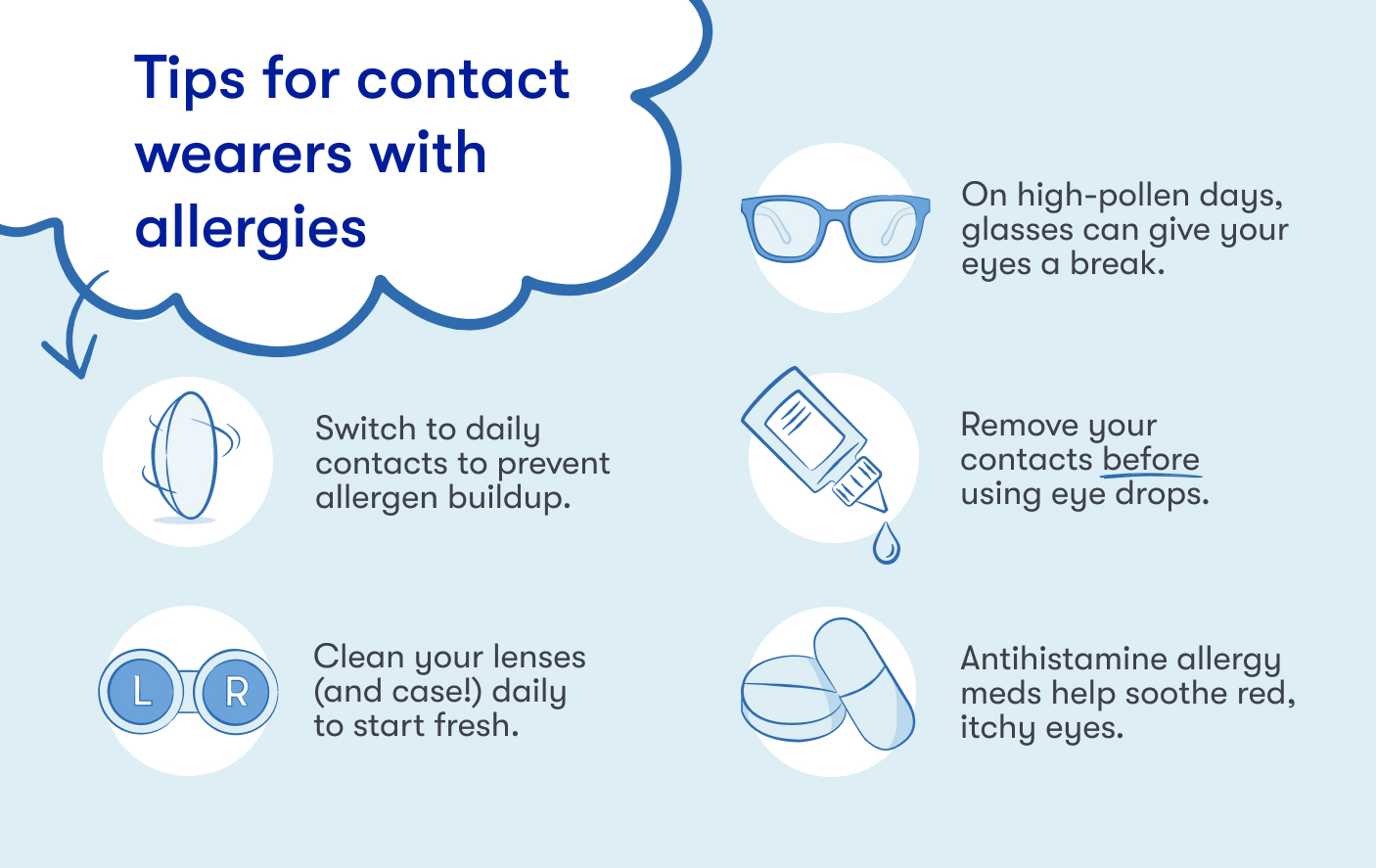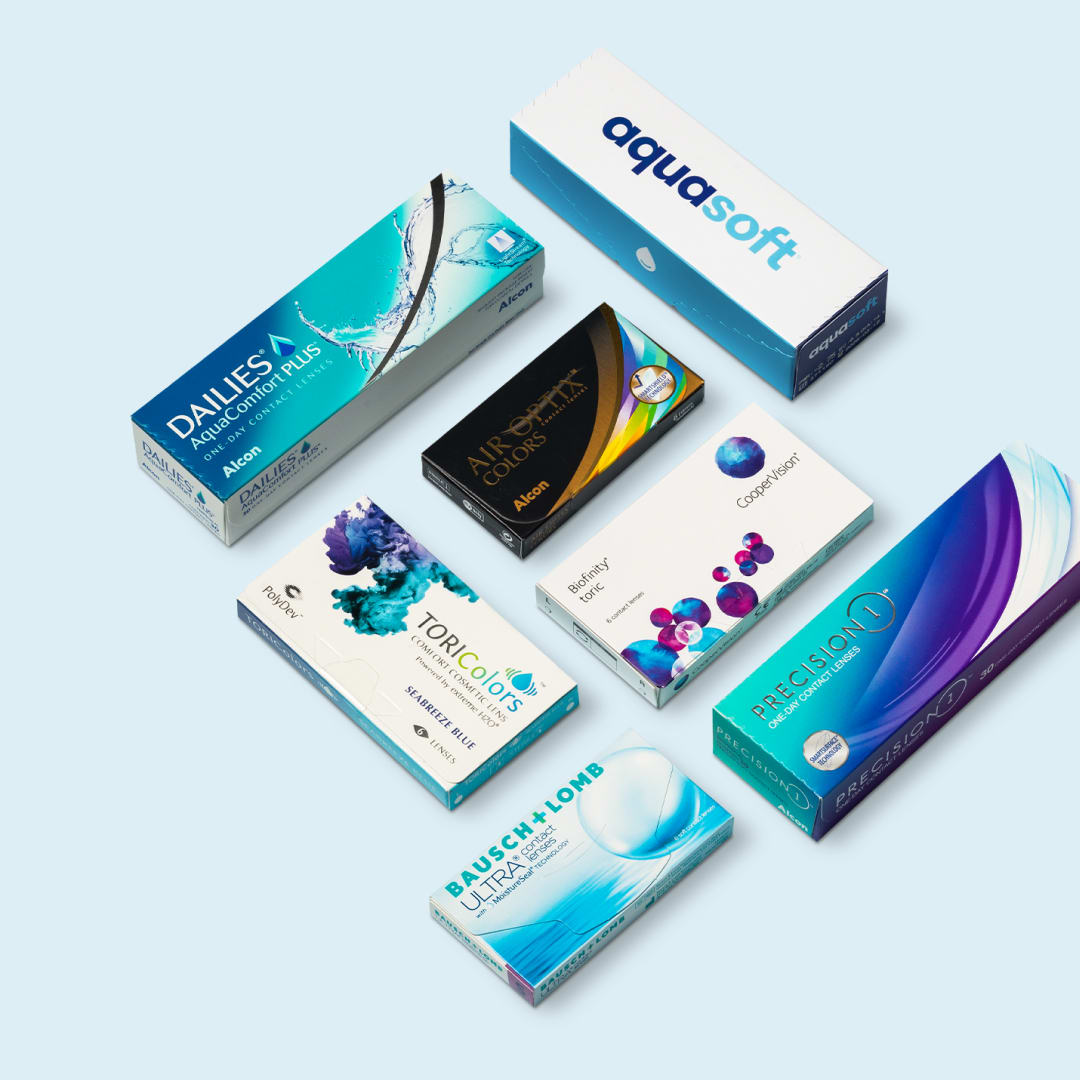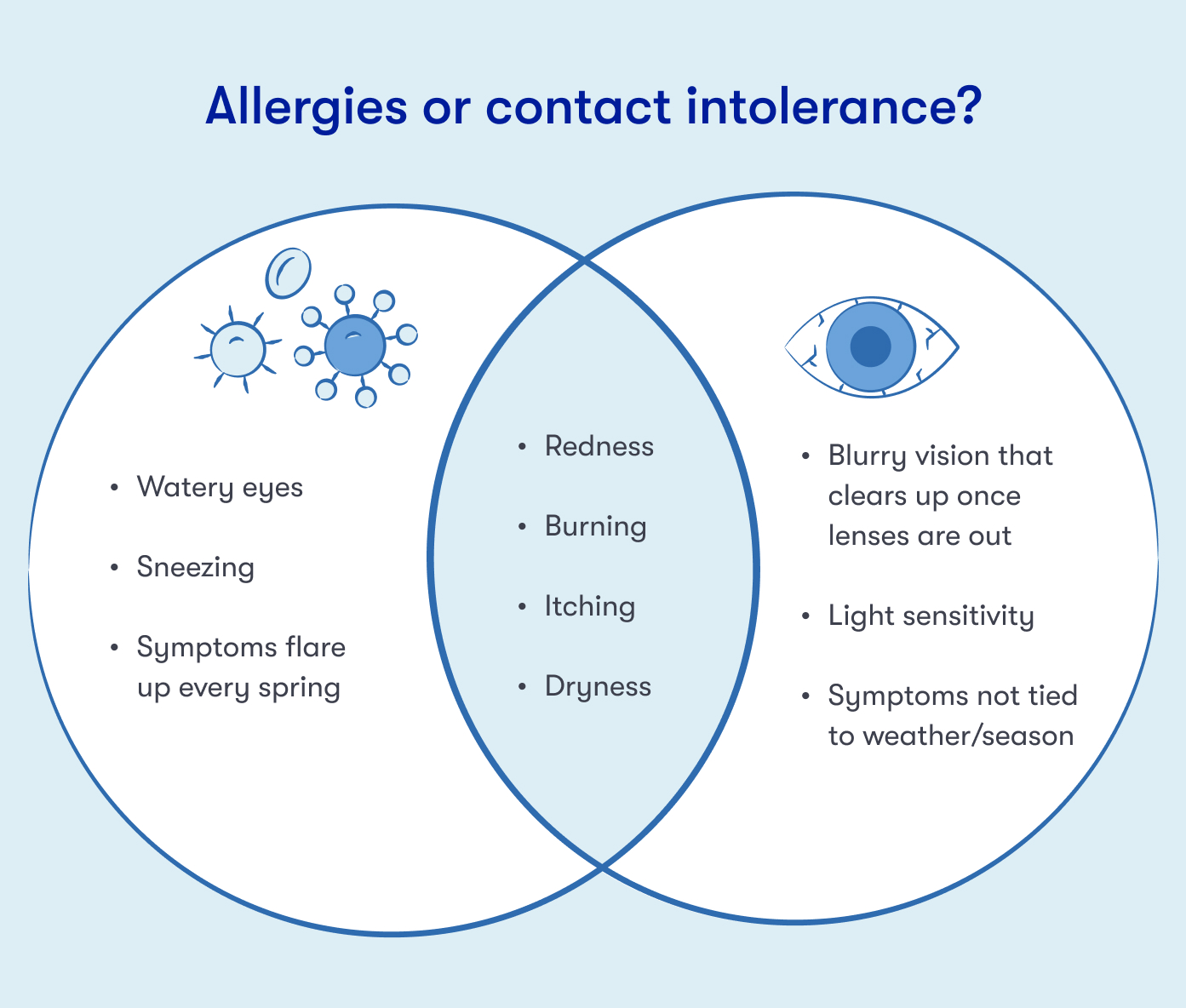Can you wear contact lenses if you have allergies?
Short version? Yes, you can wear contact lenses if you have allergies. Long version? With the right strategy (and the right lenses), you don’t have to banish your contacts to the back of the bathroom drawer.
Allergies and contacts have always had a bit of a love-hate relationship. One makes you feel like you’re blinking through a hay bale; the other helps you see the menu without pulling your phone out to zoom. So, naturally, people ask if they can wear contact lenses if they have allergies, or just give up and emotionally bond with my backup glasses?
Here’s the deal: You can usually wear contacts even if your eyes are throwing a histamine-fueled tantrum. But there are some caveats, like the fact contacts can act like tiny allergen sponges, soaking up pollen, pet dander, dust, and drama. If your eyes are red, itchy, or so watery they could qualify as a natural resource, it might be time to swap in the specs — at least temporarily.
Now, if your allergy symptoms seem to show up every time you wear contacts regardless of what the trees are doing outside, you might be dealing with something else entirely: contact lens intolerance. That’s not just your eyes being sensitive. That’s your eyes saying no thank you in increasingly dramatic ways to the lenses themselves, or to the solution they’re stored in.
So, to clear things up, we’re going to break this whole thing down:
-
Can people with seasonal or pet allergies still wear contacts? (Yes, with a few tweaks and a whole lot of eye drops.)
-
Should you wear contacts while you’re in the middle of an allergy attack? (That’s a choose-your-own-tearful-adventure situation.)
-
And can you actually be allergic to the lenses themselves — or is it just the pollen talking?
By the end, you’ll know exactly what to do when allergies strike.
Tips for managing allergies and contacts
Okay, so your eyeballs are itchy, watery, puffy, and possibly plotting your downfall. You’re not alone — contact wearers with allergies go through it. But don’t panic (and don’t throw your lenses in the trash out of spite).
You’ve got options. Here’s how to keep your contacts comfy when allergens are everywhere and your eyes are doing the most.

Start fresh (like, every single day)
Daily disposables are the MVPs of allergy season. They don’t linger long enough to soak up all the pollen and pet dander in your life (which is more than you think — yes, even that dog you only saw once 3 days ago). You pop them in, you toss them out. Zero buildup, zero guilt, fewer dramatic monologues from your tear ducts.
Still using reusables? It’s elbow grease time
If you’re sticking with monthlies or bi-weekly contacts, you’re signing up for a little more responsibility (Kind of like having a non-cactus plant that actually needs watering.)
You’ll need to clean your lenses thoroughly every single night — and no, a quick rinse doesn’t count. Switch to a hydrogen peroxide-based solution if your current one feels like it’s picking a fight with your eyeballs. And be sure to clean your lens case, too.
Some days, contacts just aren’t invited
There’s no shame in tapping out when pollen counts skyrocket. In fact, your eyes will throw you a thank-you party if you swap to glasses on high-allergen days (or after 8 hours, or the minute you get home and rip off your bra — same energy).
As a bonus, you get to look mysteriously intellectual while giving your corneas a spa day.

The Framery at 1-800 Contacts
Get premium frames starting at $79
Shop glasses
Eye drops? Yes, but do it like a pro
Squirting drops in while your contacts are still on your eyeballs is a rookie move. Most allergy eye drops need direct access to your actual eye tissue — not a soft lens forcefield.
Here’s how to do it:
-
Pop your lenses out.
-
Apply the drops (like Pataday Once Daily Relief, which works overtime against itchiness).
-
Wait 10-15 minutes.
-
Resume being fabulous.
You can use artificial tears with contacts in but stick with preservative-free formulas that are labeled contact lens safe.
And yes, you might need meds
Allergy meds aren’t just for noses. Antihistamines can help keep your whole face in check — including your eyes. If you’re already taking something like loratadine or cetirizine, that’s great. But if your eyes still feel like they’ve been personally insulted by spring, you might need to add drops, change your lens type, or — gasp — actually rest.
(Also, stay hydrated. Dehydrated eyeballs + allergy meds = dry-lens tragedy.)
In summary:
-
Dailies = fewer allergens and better vibes
-
Reusables = extra cleaning and grown-up contact energy
-
Glasses = comfort, mystery, and the right to blink freely
-
Eye drops = magic — but only if used properly
-
Antihistamines = a little help from science
It doesn’t take much to get your eyes back on speaking terms with your lenses. A few small swaps, a solid backup plan (hello, glasses), and the occasional over-the-counter assist can get you through even the sneeziest season. Next up? Let’s talk about the drops themselves — because not all bottles are created equal.
Allergy eye drops for contact wearers
The key to soothing allergy eyes without turning your contacts into tiny sponges of doom? Picking the right drops and using them the right way. Antihistamine drops can calm itching and irritation, but you’ll need to remove your lenses first and wait 10-15 minutes before reinserting them (use the time to scroll memes or hydrate — your call).
For all-day comfort, preservative-free artificial tears like Systane Ultra are great with lenses still in. Still struggling? A peroxide-based cleaner like Clear Care Plus gives your lenses the spa day they deserve — without the cucumber slices.

Order Contact Lenses Online
Learn how to order contact lenses online at 1-800 Contacts
Order contacts
Best contacts for people with allergies
If your current lenses feel like they’ve been collecting pollen as a hobby, it might be time for a fresh start — literally. Daily disposables are widely considered the best contacts for people with allergies, because you’re tossing the lens (and the day’s allergen baggage) every night. No buildup, no cleaning, no mysterious eyeball betrayal at 4 p.m.
There are a lot of options out there, so to spare you from opening 27 tabs and spiraling, here’s a quick breakdown of daily lenses that play nice with sensitive, allergy-prone eyes:
-
-
For: Dry, itchy eyes that hate springtime
-
These lenses use a moisture-rich cushion to help keep eyes hydrated throughout the day — basically a weighted blanket for your corneas. A protective shield of built-in UV defense is the icing on this contact lens cake.
-
-
-
For: Blinkers (You know who you are.)
-
These refresh with every blink — perfect for long screen sessions or when you can’t stop rubbing your eyes like you’re trying to summon a genie.
-
-
-
For: People who want moisture but make it high-tech
-
Designed with tear-like properties to support your eye’s natural environment. (Basically science cosplay for your eyeballs.)
-
-
-
For: Eyes that get cranky by lunchtime
-
Mimics your eye’s biology and holds moisture for up to 16 hours. Feels like your eyes just drank a very expensive smoothie.
-
-
-
For: Budget-friendly allergy relief
-
A great all-around daily lens that won’t break the bank (or your eyes). Silicone hydrogel + UV blocking = a solid win.
-
-
-
For: Maximum bougie eye comfort
-
These are water-gradient lenses that feel like nothing. (Seriously — many people forget they’re even wearing them. Until the part where they can see.)
-
-
-
For: All-day wearers with sensitive eyes
-
Comfortable, breathable, and designed to help your eyes stay chill — even when allergy season refuses to.
-
If you’ve been wrestling with itchy eyes, rapid blinking, lens discomfort, and the urge to yeet your contacts into a hedge, the right dailies can make all the difference.
Ask your eye care professional which of these fits your prescription — and maybe keep your backup glasses nearby (just in case your cat is secretly shedding adorable vengeance).
Seasonal allergies vs. contact lens intolerance
Not all red, itchy eyes are created equal. Sometimes, it’s just seasonal allergies doing their pollen-dusted worst. Other times, it’s your actual contacts — or the solution they’re swimming in — causing trouble.
Contact lens intolerance happens when your eyes stop vibing with the lens itself. This can be due to lens material, protein buildup, or even preservatives in your solution. It’s like your eyes suddenly deciding, “We’re not doing this anymore.”
Here’s the tricky part. Allergy symptoms and intolerance symptoms often look the same — burning, redness, dryness, and The Itch™. But allergies usually bring watery eyes and sneezing along for the ride, while intolerance shows up the longer you wear your lenses (especially late in the day).
If your symptoms flare up every spring, that’s likely seasonal. But if they pop off no matter the forecast, your lenses might be the problem. Let’s break down the signs in the next section.

What are the symptoms of contact lens intolerance?
If your lenses used to feel like clouds and now feel like regret, your eyes might be over it. Watch for these signs:
-
Redness that creeps in like a bad mood
-
Burning or stinging (like your lenses are throwing shade)
-
Blurry vision that magically clears up once the lenses are out
-
Dryness that no amount of blinking fixes
-
Light sensitivity (suddenly, every light is too light)
-
Feeling like your eyes want to call HR
How do you treat contact lens allergies?
The goal isn’t to power through itchy eyes like you’re in some kind of ocular boot camp. It’s to fix the problem so you can wear contacts without feeling like your eyeballs hate you.
-
Switch to glasses temporarily. Let your eyes reset without pushing through the discomfort.
-
Upgrade to dailies like PRECISION1®, so you’re not reusing allergen-covered lenses.
-
Use allergy drops the smart way. Contacts out, drops in, wait 10-15 minutes, contacts back in — yes, every time.
-
Try a peroxide-based cleaner. It deep-cleans lenses so thoroughly it’s almost suspicious.
-
Add preservative-free lubricating drops. These help rinse away allergens and keep eyes moist not miserable.
-
Talk to your eye care professional. They can help rule out lens material issues, solution sensitivities, or something else entirely.
Less suffering, more seeing. That’s the vibe.
Do contact allergies go away?
They can but only if you know what you’re dealing with. If the issue is seasonal allergies, your eyes are reacting to things like pollen, dust, or pet dander hitching a ride on your lenses. Those symptoms usually disappear once the allergens do.
But contact lens intolerance is a different beast. If your eyes are reacting to the lens material itself no amount of drops will fix that. You’ll need a better lens match, a different cleaner, or possibly a new plan altogether.
In either case, relief is possible. Allergy drops can soothe symptoms, daily disposables reduce buildup, and peroxide-based cleaners help banish the gunk your lenses collect like it’s their side hustle. The goal? Clear, comfy vision — without having to psych yourself up every time you put your contacts in.
Did you know you can order contacts online?
Say goodbye to trips to the eye doctor and hello to convenience! With 1-800 Contacts, you can easily order your contact lenses online and have them delivered straight to your door. Plus, our online vision exam makes it simple to get the prescription you need without leaving home. And the best part? You’ll save money on your first order with 1-800 Contacts. It’s never been easier to get your contacts!
Original author: Austin Brewer
Original published date: 1/24/2020
Updated: 6/16/25





